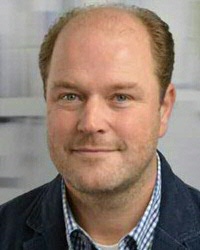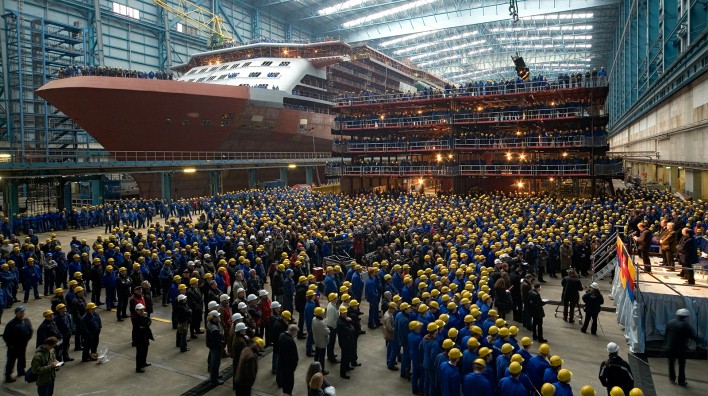Peter van Kampen over de samenwerking met Duitse instellingen

Op slechts 50 kilometer afstand ten oosten van Groningen bevindt zich de vierde grootste economie ter wereld. Hoewel de fysieke grens met Duitsland weinig meer voorstelt, zijn er mentale drempels waardoor de samenwerking van Nederlandse bedrijven met de Duitse profit- en non-profitsector verre van optimaal is. Peter van Kampen wil hierin verandering brengen. ‘Het lijkt wel of we sneller in China zijn dan bij de buren.’
Tekst: Gert Gritter, afd. Communicatie
Van Kampen is plaatsvervangend directeur van UGNWG (University of Groningen North West Germany), naast directeur Harald Orfgen. De UGNWG is een lokale dependance van de RUG in het Duitse Papenburg, die nauwe banden heeft met instellingen in Noordwest-Duitsland en opereert daar in het kader van Northern Knowledge. Deze regio heeft op economisch gebied veel te bieden, zegt Van Kampen. ‘Er zijn grote bedrijven gevestigd. Voorbeelden zijn UPM Nordland Papier in Dörpen, de grootste papierproducent voor drukwerk ter wereld, en de Meyer Werft in Papenburg, waar enorme cruiseschepen worden geproduceerd. Maar er zijn natuurlijk ook overheidsinstellingen en veel kleinere ondernemingen.’
Van Bremen tot Den Helder
Van Kampen denkt ‘über-regionaal’. ‘We willen de komende tijd de ontmoetingen op locatie tussen de RUG en bedrijven in Noordwest-Duitsland intensiveren. Het doel is de overdracht van publiek-private kennis van Bremen naar Den Helder in Noord-Holland te intensiveren. Met de RUG en haar vestiging in Leeuwarden (de Campus Fryslân) als partners en tussenstations. We richten ons trouwens niet op héél Duitsland, maar op het noorden van Nederland en het noordwesten van Duitsland. Dat is een gebied dat van oudsher veel connectiviteit heeft. Er waren en zijn veel culturele en historische overeenkomsten en verwantschappen, op het gebied van taal, inrichting van stad en landschap, handel, godsdienst. Vergeet niet dat Ubbo Emmius, de eerste rector van de RUG, uit Oost-Friesland kwam. Ook momenteel heeft de RUG een sterke link met Duitsland en Duitsers. Zo’n 10% van de 30.000 studenten is Duits en er werken ook nog eens 500 Duitsers als onderzoeker en docent. Daarmee zijn we eigenlijk een Duitse universiteit. Ik zie mezelf vooral als pionier, een verkenner. Ik leg contacten in de regio en maak flexibele afspraken met stakeholders, zoals grensgemeenten, bedrijven, overheidsinstanties. Het valt me op hoe weinig de RUG bekend is; in het verleden hebben we daar nooit ons best voor gedaan. Toch merk ik dat er in Duitsland veel belangstelling is voor samenwerking. De RUG is een mondiaal bekende naam. We hebben een traditie van 400 jaar van academisch excellentie, maar buitenstaanders weten vaak niet op welke specifieke onderzoeksthema’s de RUG zich onderscheidt.’

Werkgelegenheid
Het is ook belangrijk de samenwerking tussen de RUG en Noordwest-Duitsland te zien op het terrein van werkgelegenheid. Van Kampen: ‘Aan de RUG volgen 30.000 jongeren een studie op academisch niveau en zijn er een paar duizend wetenschappelijke onderzoekers. Dat is voor het Noordwest-Duitse bedrijfsleven, dat voortdurend op zoek is naar goed gekwalificeerde medewerkers, erg interessant en ook vice versa, want er liggen interessante loopbaanperspectieven voor stagiairs en afgestudeerden.’ De UGNWG is gehuisvest in het Marienhospital Papenburg, waarmee al een lange tijd een relatie bestaat. Het Groningse bureau verzorgt onder meer tweeweekse stages voor RUG-studenten van de Faculteit Medische Wetenschappen. Al meer dan 125 hebben dat gedaan. Van Kampen: ‘Als een vervolg op deze succesvolle kortdurende stages, gaan we langere stages van een half jaar organiseren voor studenten die praktijk moeten opdoen bij de spoedafdeling van een ziekenhuis in het kader van hun artsenopleiding.’
Samenwerking met de Meyer Werft
Tot dusver is het grootste succes van de UGNWG de overeenkomst voor samenwerking die de RUG heeft gesloten met de Meyer Werft Papenburg. Op 23 juli 2018 tekenden Sibrand Poppema, destijds de voorzitter van het College van Bestuur van de RUG, en Tim Meyer, de directeur van de werf, een memorandum van overeenstemming voor langjarige samenwerking. Beide partijen bundelen hun krachten in IB2050 (Innovation Lab Papenburg-Groningen 2018-2050). De bedoeling is concrete, duurzame en concurrerende ideeën te bedenken voor de bedrijfsprocessen bij de Meyer Werft. Van Kampen: ‘Of, om het eenvoudiger te zeggen, Meyer is geïnteresseerd in de vraag hoe het als Duits familiebedrijf in een zeer competitieve sector overeind blijft. Met de kennis die wij aan de RUG ontwikkelen en vermarkten kunnen wij ze daarbij een stap verder helpen.’

IT
De eerste drie projecten van het innovatielab hebben betrekking op IT, duurzaamheidrapportage en energie-efficiëntie. IT speelt een grote rol in de productieomgeving op de Meyer Werft. Daarom verkent de werf samen met de onderzoeksgroep van Bayu Jayawardhana (hoogleraar Mechatronica en regeltechniek voor niet-lineaire systemen) toepassingen van de volgende generatie IT. Door te besparen op kosten en ontwikkelingstijd kan de productiviteit worden verbeterd. Het doel is de ontwikkeling van ICT-technologie waarin modelgebaseerde benaderingen (‘digitale tweelingen’) worden gecombineerd met benaderingen op basis van big data.
Duurzaamheid en energie-efficiency
Meyer Werft is een wereldspeler in de scheepsbouw. Daarom wil het bedrijf vooruitlopen op de internationale normen voor duurzaamheidsdoelstellingen, waaronder de GRI’s (Global Reporting Initiatives). In samenwerking met Alan Muller, hoogleraar International Management, is een project gestart om een systeem voor internationaal erkende en gestandaardiseerde verslaglegging te ontwikkelen. Cruiseschepen verbruiken veel energie. Een scheepsbouwer als Meyer Werft wil graag energiezuinige schepen ontwikkelen, die zo efficiënt mogelijk zijn. De groep van Jacquelien Scherpen (hoogleraar Discrete technologie en productieautomatisering) gaat samen met het bedrijf onderzoek verrichten op het gebied van energie-efficiëntie, smart grids, en hernieuwbare energie.
Future Rooms
Hoewel Papenburg en Groningen slechts 60 km van elkaar verwijderd liggen, is veel en direct contact en communicatie tussen de RUG en de Meyer Werft essentieel. Daarom wordt er prioriteit gegeven aan het opzetten van zogenaamde Future Rooms (FR) in beide plaatsen. In deze ruimten zijn geavanceerde communicatievormen geïnstalleerd, waard de coördinatie plaatsvindt en de interactie tussen studenten en staf vergemakkelijkt wordt. Het heen en weer reizen kan daardoor worden beperkt. De ‘Zukunft-Raum Papenburg’ wordt gerealiseerd op de werf of in de stad. De FR in Groningen komt waarschijnlijk te staan op de Zernike Campus van de RUG, in het Start Up City-gebouw.
